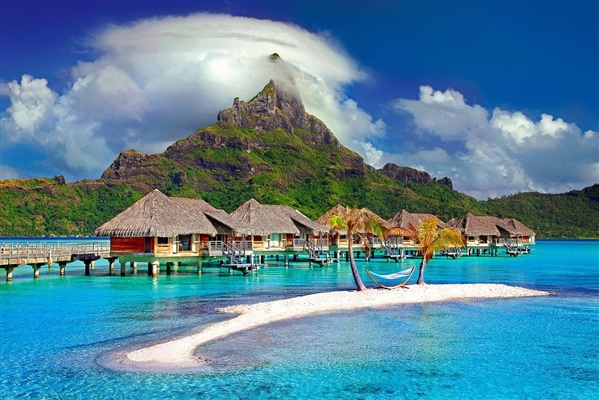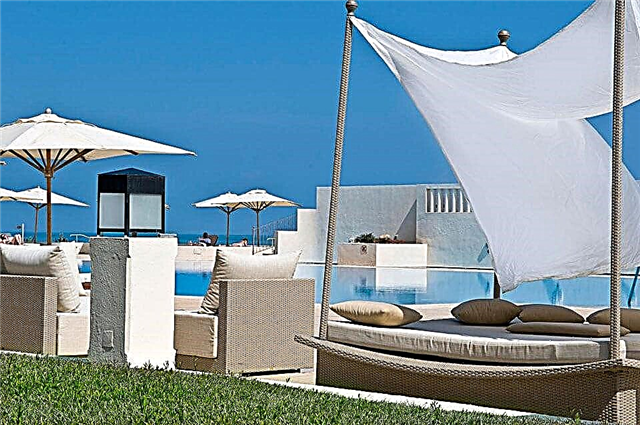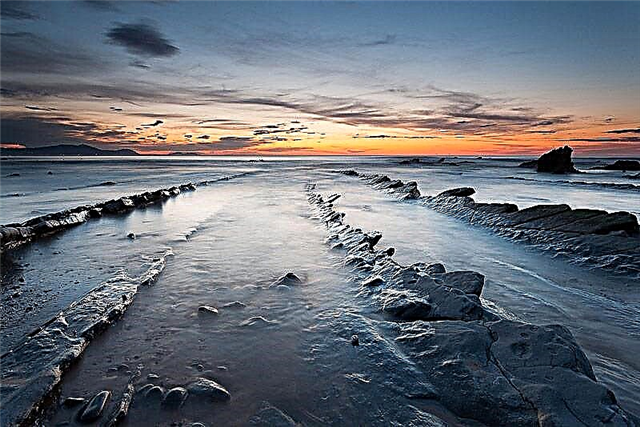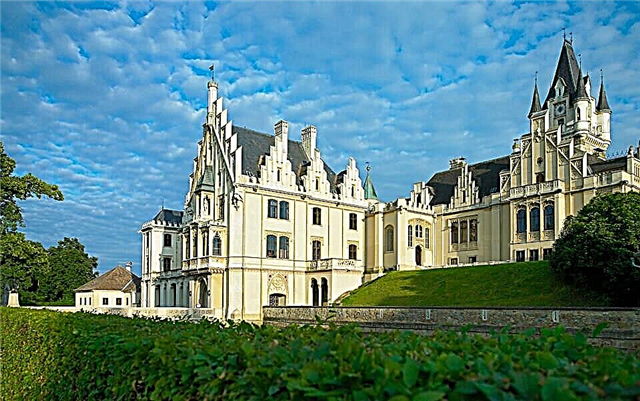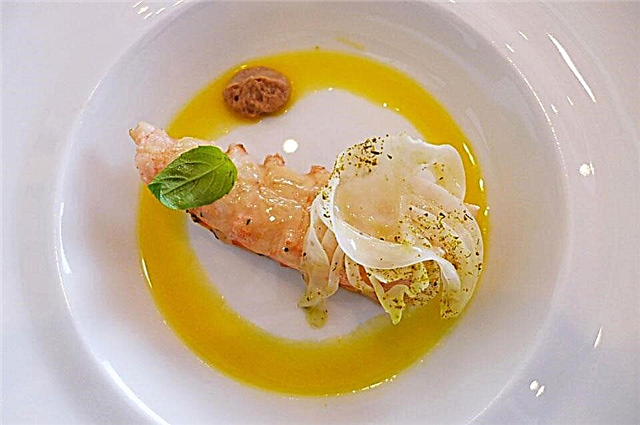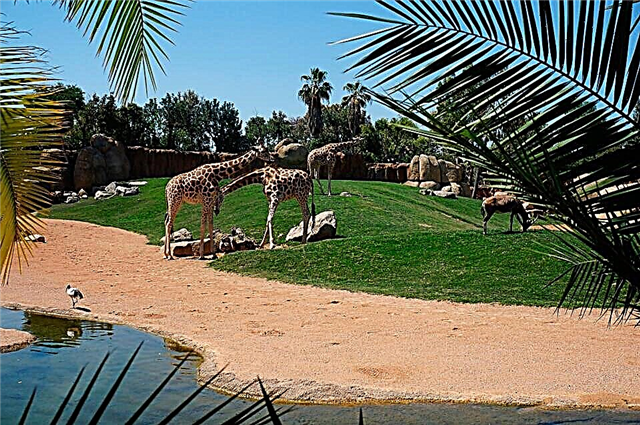Valencia is an ancient Spanish city, the mention of which can be found already in the II century BC. Located in the eastern part of the country on the Mediterranean coast. This location served the fact that over the centuries the city was subject to conquests and belonged to different cultures: Romans, Muslims, Christians. Each period left its mark and left the amazing sights of Valencia, which are worth being proud of. The past and the present are intertwined here, there is no usual city bustle. Medieval buildings with their secrets, paintings, unique architecture side by side with modern works worthy of admiration. The beautiful Blue Flag beaches are the perfect start or end to your day. If you decide to visit this unique city, where history, music and architecture lovers will find entertainment. Every traveler tries to discover his Spain and its ancient city. Here is a short list of the most popular sites.
Cathedral

The beautiful Gothic Cathedral of the Virgin Mary is one of the main attractions of the city and its symbol. It also has another name - the Cathedral of the Assumption of the Mother of God. Previously, in its place stood the temple of Diana, which was erected by the Romans in honor of the goddess of the hunt. Later it belonged to the Visigoths until it was destroyed by the Arabs, who later erected a mosque on the ruins. Then the Spaniards came and instead of the mosque they demolished, they laid the foundations of the cathedral.
It happened in 1262. Construction lasted 94 years and the next few hundred years, the cathedral was rebuilt several times. That is why you can see a mixture of several architectural trends here. It is crowned with an octagonal tower (Bell Tower of Mikalet), the height of which is 65 m. To admire the view of the city from this height, you will have to climb a spiral staircase and overcome 207 steps.

The western façade and the Apostolic Gates open onto the Saint Virgin Square, a traditional meeting and meeting place. Once upon a time there was a Roman forum, and today it is decorated with a fountain with allegorical figures. Why is the gate so named? It's simple, at the entrance to the cathedral there are sculptures of the 12 apostles. The oldest gate, the Palace gate, overlooks Almoyna Square. The Iron Gate (Los Hierros), which overlooks the Queen's Square, is made in the Italian Baroque style. They were erected in the beginning. XVIII century
One part of the building houses the Cathedral Museum, which houses paintings by talented Renaissance artists, including paintings by Francisco Goya and Juan Juanes. But the most interesting shrine that attracts tourists here is the Holy Grail, from which Christ drank during his last supper. Archaeologists have established that the Chalice was created in the 1st century BC. AD, and the Vatican recognized her as "a witness to the steps of Christ on earth."
Lonja de la Seda Silk Exchange

The Silk Exchange was built in the 15th century. She became a symbol of the Golden Age of the city. At the time, Valencia was the European center of the silk trade and was home to several hundred talented silk craftsmen. Today Lonja de la Seda is inscribed on the UNESCO World Heritage List. This is one of the stunning and well-preserved examples of Mediterranean (Southern) Gothic with Renaissance décor.
Lonja de la Seda is very reminiscent of a medieval castle. The facades of the building have strict forms and are made of stone. Gargoyles, coats of arms and other details that catch the eye of everyone, impeccable proportions of window and door structures - all this is really impressive. You can find the Silk Exchange at the Market Square (Plaza del Mercado). Doors for tourists are open daily, Mon - Sat from 9:30 am. until 19 pm. On Sundays and holidays from 9.30 a.m. until 15 o'clock in the afternoon. Weekends - 26.12, 01 and 06.01, as well as 1.05. On the last day of the week and on holidays, admission is free for everyone.
Museum of Fine Arts

This is one of the most visited museums in the country. It keeps one of the richest art collections. It is located in the building of the former theological seminary of St. Pius V. It contains a collection of works by famous Renaissance artists from Europe (El Greco, Francisco Goya, Bosch, Velazquez, etc.), and this is almost 2 thousand paintings, as well as the work of talented sculptors. The storerooms contain works of the graphic genre, which are contraindicated in solar lighting. There is no permanent exhibition.
To store unique collections, special conditions are required, adherence to temperature conditions. After all, one has only to imagine what value the works of Giovanni Piranesi have. The museum contains about 800 prints. Also, this place will be interesting to visit for connoisseurs of contemporary art. The address of the museum is C / San Pío V, 9 and is open Tue-Sun from 10 am to 7 pm and on Monday from 11 am to 5 pm. Free admission.
City of Arts and Sciences

The futuristic architecture of the City of Arts and Sciences complex, spread over 350,000 m² on the drained bottom of the Turia River, is striking in its uniqueness. It includes:
- The Reina Sofia Palace of Arts, which looks like a sea liner, as if flying out of the sea, includes 4 halls for 4200 spectators.
- Hemisphere is a fantastic structure that resembles a half-open human eye peeping out of the water. It serves as a planetarium, an IMAX cinema and a laser show room.
- L'Umbracle - a grandiose arched metal structure with a gallery of modern sculpture, a greenhouse and a garden with 5 thousand species of exotic vegetation
- the Prince Felipe Science Museum, which, from the outside, evokes an association with a huge sea animal stretching for 2 km. In the museum, which occupies 4 floors, all exhibits are allowed to be touched by hands.
- an open-air oceanography park, where half a thousand species of marine fauna live in two-level glass aquariums.
It is profitable to buy complex tickets. Ticket offices are open from 10:00. The pavilions are open every day from 10:00 to 20:00 from July to September. In other months - from 10:00 to 18:00.
Entrance ticket to the Oceanographic Park - € 30.70
Biopark ticket - 23.80 €
Tourist card for 24, 48, 72 hours - from 15 €
Tourist card of Valencia for 7 days - from 12 €
Prince Felipe Science Museum

Museum of Science - the largest building, which is part of the architectural complex "City of Arts and Sciences". For 16 years (built in 2000) more than 25 million people have visited the museum. The famous architect Santiago Calatrava worked on the project. The whole structure looks massive enough. Its length is 250 m, and its height reaches 33 m. It is supported by 5 columns. Inside, the room looks quite spacious, this effect is achieved due to the fact that the facade is made of glass.
Here you can visit the Titanic exhibition, which will tell guests the tragic story of the ship's wreck. But it will be interesting to spend time here not only for adults, but also for children, since a huge number of interactive exhibitions have been created here for them. The boys are happy to test the device that measures the force of impact of the foot on the ball. On the spot, you can compare which famous football player has the same blow. There is also a separate room where you can watch a chick hatch from an egg.
You can move around the complex not only on foot, but also by bicycle, and if you are tired, then by a special train. Experienced tourists recommend arriving an hour before the opening to take futuristic photographs of this place. The address of the Prince Felipe Science Museum is Avenida del Profesor Lopez Pinero, 7. Opening hours: Mon-Thu from 10 am to 6 pm, Fri-Sun from 10 am to 7 pm.
Oceanographic Center

In the largest oceanographic center in Europe, which is part of the City of Arts and Sciences complex of buildings, you can meet 500 species of various animals and 45 thousand fish from all over the world. Forget everything you've seen in other countries. This center is incomparable with any other. It covers an area of 110 thousand square meters, and the total volume of water in aquariums is 42 million liters. Just imagine this scale!
There are several rooms here, each of which belongs to a specific geographic area. There is even a dolphinarium where you can watch an amazing show. You will also be amazed by the 70 meter long tunnel. We highly recommend visiting this place. The center is open daily from 10 am to 6 pm. In summer, it works until 20 pm, and sometimes until 1 am. The schedule can be found on the official website.
Albufera Natural Park

20 km from the city is the stunning and picturesque Albufera Park, which is also called the "Paradise of Birds". More than 350 species of them live here. In 1986, the area around the lake was recognized as a natural park of Valencia, and since 1990 - a wetland of international importance. Its area is over 20 hectares. A free visiting area is open. In the reserve, you can rent a boat and enjoy the beauty of the lake. Several excursion routes have been developed, allowing you to get acquainted with different species of birds: storks, cranes, herons.
Among them are representatives of the Red Book: Athany Iberian (Fartet), Samarug (Samarugo) and others. One of the programs includes a visit to the village of El Grau. The small salt lake is inhabited by unique waterfowl. Equipped beaches are protected from the winds by dunes, along the edge of which pine trees grow. Comfortable campings and hotels are equipped for tourists. We also recommend trying the aromatic and delicious paella made from local rice at a local restaurant.
There is fish in the lake, but fishing is prohibited here. You can get to Albufera Park by bus number 25 (EMT Valencia) and number 190b (MetroBus). Open for visits (October-March) from 9 to 17 hours, (April-September) from 9 to 18 hours.
Mestalla stadium

Mestalla is the stadium of the Valencia football team, where they won the Spanish Cup in 1941. It was built in 1923 as the home stadium of the famous local football club. But during the years of the civil war, they not only grew vegetables on it, but also kept those arrested before being sent to a concentration camp. In 1992, he was honored to host matches of the 1992 Summer Olympics, and in 1982 - the World Cup.
At present, the stadium, after reconstruction, which ended in 2001 for the Champions League matches, is capable of accommodating up to 55,000 spectators. Over its more than 90-year history, it has been reconstructed and modified 6 times. Sightseeing tours are organized at the stadium, allowing you to look inside the building.Address of the stadium: Avenida de Suecia s / n.
Royal gardens

Tired travelers can relax in the Royal Gardens. This park was created to decorate the area around the royal palace. The palace is no longer there, but the charm and luxury of this place for relaxation, walks and communication with nature begins from the gate, on which the royal crown flaunts. This kingdom of nature, created by man, gives the weary traveler coolness and relaxation.
Well-groomed lawns, beautiful flower beds, exotic plants are the components of this piece of landscape art. There is a biopark on the territory of the gardens, where you can see animals not in a cage, but in their natural environment, where they feel great. The Natural Park of Valencia was founded in 1560 by order of King Philip II, who wished to see a beautiful, well-groomed area around his palace. It is located on the banks of the Turia River in the area of the Museum of Fine Arts.
Fulfilling the will of the monarch, gardeners planted a huge number of different plants. There are many subtropical among them: rare species of magnolia, hibiscus, palm, orange and tangerine trees. The Pyrenees War of 1810 caused significant damage to the landscape gardening ensemble. The palace itself was destroyed. Francisco Javiera de Elio went to great lengths to restore the damaged park. About 4,000 rare trees and shrubs were planted here again. At the moment, plants from all over the world grow in the garden. Organized a menagerie and a Museum of Natural Sciences, which includes collections of insects and molluscs.
Biopark

The Valencia Biopark, the largest in Europe, is located in the northern part of the Turia River Gardens. It is called the prototype of the zoo of the future, where a natural habitat for animals has been recreated on an area of 100 thousand square meters. There are no animal cages here. They are separated from human contact by a chain of ditches, water barriers, embankments of stones and, in especially dangerous places, by a glass wall. In the created ecosystems "African Savannah", "Madagascar", "Equatorial Africa" there are 250 species of animals and birds, numbering more than 4 thousand.
In the center of the zoo, there is an amphitheater with 1,000 seats, where performances with the zoo's birds and mammals are held. You can observe the habits of animals living in picturesque landscapes all year round, except for January, every day from 10:00 to 17:00, in summer until 21:00.
Prehistoric Museum

The Museum of Prehistory and Ethnology of Valencia, located in the Charity Cultural Center, is dedicated to human development. The modest three-story building contains many historical artifacts of interest and surprise. The halls dedicated to the prehistoric era present artifacts found during excavations in and around Valencia: Neolithic tools, household utensils belonging to ancient Valencian artisans and peasants.
Some of the museum halls are dedicated to antique sculptures, coins of Valencia and Spain from ancient times to our time. The permanent exhibitions are complemented by exhibitions representing individual eras. The museum opens its doors to visitors every day at 10:00 and is open until 20:00, except Monday. Admission is free on weekends and holidays.
Serranos gate

They are two Gothic towers, built in 1392-1398 by the architect Pere Balaguer using the latest achievements of fortification science. At that time, they were part of the chain of the fortress wall. Their powerful appearance makes it clear that they were built so that the city could withstand a long siege and repel the enemy. In the thickness of the towers in 1936, on the eve of the war, a cache was arranged, which made it possible to preserve the values of the Prado Museum in Madrid.
By coincidence, the gate began to serve as a place of solemn entry into the city of the king and noble persons, and in our time - for holding various solemn public events. The Museum of the History of the Navy has been established here. Its expositions tell not only about sea battles, but also demonstrate the finds made by underwater archaeologists. The upper part of the towers is equipped with an observation deck, from where a view of the historical center of the city opens onto the riverbed of Turia.
They annually announce the beginning of the fire festival - La Fallas. There is a museum in the towers, available for visits: Tuesday-Saturday from 10: 00-14: 00 and 18: 00-20: 00. Sunday and Holidays - 10: 00-14: 00.
Gate Quart

National historical monument - the Quart gate, built in the middle of the 15th century in the city wall, for several centuries served as a reliable defense against enemy attacks and opened the entrance to the center of Valencia. The gothic stone gate of Quart looks like a massive structure with an arch connecting two towers in the form of cylinders. Above the arch, where the angel was previously adorned, there is a relief image of the coat of arms of Valencia. The smooth surface of the tower walls keeps traces of shells received from the bombing of the city by Napoleon's army.
The upper part of the gate, which today serves as excellent viewing platforms, is surrounded by massive stone battlements alternating around the perimeter of the fence. It is possible to enjoy the panorama of the city from the tower height from Tuesday to Saturday from 10:00 to 14:00 and from 18:00 to 20:00, on Sundays and holidays from 10:00 to 14:00.
Botanical Garden

The botanical garden, founded in the 16th century, is the oldest natural attraction in the city. It is located near the watchtowers of Quart. The territory began to be developed in 1567, when the first plantings were carried out. At that time, these were mainly medicinal plants. Gradually, the collection began to be replenished with other representatives of the flora from all over the world. It currently covers an area of almost 1.5 hectares. Over 5 centuries, 4,500 species of flora from all over the world have appeared in the garden, growing in the open air, in greenhouses and greenhouses.
The main part is devoted to the Botanical School. It is equipped in such a way that it is possible to trace the evolutionary development of nature on the planet, from mosses to complex plants. Also, there is a chance to see many exotic trees, rare shrubs, vines, tropical, aquatic and medicinal plants.
The garden, filled with the aromas of blooming vegetation, is equipped with original recreation areas with decorative fountains, gazebos and a network of walking paths. It often hosts international events dedicated to the study of nature, gardening and the cultivation of various cultures. Several years ago there was a tradition to organize an exhibition and sale of orchids on Mother's Day (on the first Sunday of May).
You can relax in the garden at any time of the year: from May to August - from 10.00 to 21.00; in April and September - from 10.00 to 20.00, in March and October - from 10.00 to 19.00; from November to February - from 10.00 to 18.00.
Palace Generalidad
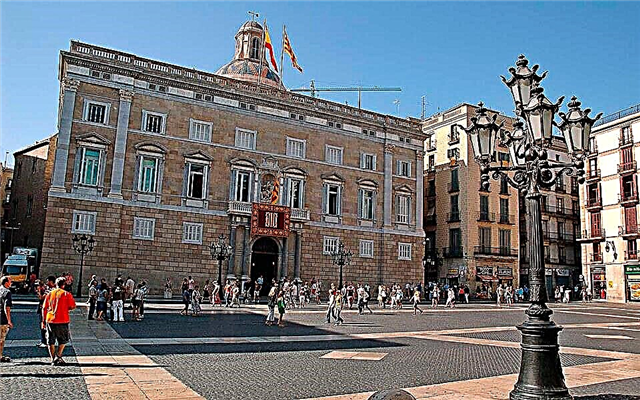
On the central square of the Holy Virgin, the government building, the Generalidad Palace, dating back to 1421, stands out as a vivid example of Valencian architecture. He embodied in his architecture the late Gothic style combined with Spanish Herresco, Renaissance and Classicism. The halls of the palace are of great cultural value:
- the hall of the Cortes, intended for meetings of deputies, amazes with the skill of the frescoes and wall paintings depicting the deeds of the three departments of the Cortes
- The "Royal Hall", used for ceremonies and receptions, is decorated with portraits of the city's rulers
- The "Golden Hall" striking with a ceiling with gilded decoration in the Renaissance style.
Impressions of the luxury of the halls will be complemented by paintings by Valencian painters and art objects exhibited in other halls. The masterpieces can be viewed free of charge from Monday to Friday from 9:00 to 14:00.
City Hall Square

The main square of Ayuntamento, which stands out in the shape of a triangle, is called the decoration of Valencia. Its main accent was the snow-white city hall building, the facade of which is richly decorated with statues, skillful stucco molding and columns. An interesting city coat of arms with a bat over the crown and marble female figures on the sides, personifying literature and art. Inside the City Hall, the interior of the Crystal Hall with original stained-glass windows and Bohemian crystal chandeliers deserves attention. Some of the rooms are reserved for the Historical Museum with a large collection of works of art. You can visit the City Hall from Monday to Friday from 10:00 to 13:00 for free.
The square is surrounded by sights along the perimeter:
- the eclectic Palace of Communication with a glass dome decorated with stained glass windows from the 48 provinces of Spain
- Merchant Assembly, with a series of arches rising up from the balcony to the top floor
- the Rialto theater - an example of rationalism
The picturesque area is given by the abundance of flowers around the voluminous bowl of the fountain.
Queen's Square

Queen's Square appeared in the center of the Old City in honor of the marriage of King Alfonso XII of Spain in January 1878. It faces the northern facade of the Gothic Cathedral of St. Mary with the main entrance - the Iron Gate of the Italian Baroque style. On the openwork carved facade, graceful columns with pilasters, statues of saints, an abundance of decorative stucco moldings and reliefs admire. The luxury of the interior of the temple can be seen from Monday to Saturday from 10.00 to 18.30, Sunday from 14.00 to 18.30. FROM
Near the cathedral, the octahedral bell tower of Miguelete, a Gothic building of the 15th century, rushed up to 68 meters. The climb to its observation deck, which reveals an amazing panorama of Valencia and the surrounding area, costs 2 €. Opposite it is the bell tower of the Church of St. Catalina from the beginning of the 18th century.
Crypt of the Holy Martyr Vicente

The Visigothic chapel houses the most ancient landmark of Valencia - the 6th century Crypt with the relics of the Holy Martyr Vicente, who was burned for the spread of Christian teachings in 304 in Valencia by the order of the Roman emperor. It differs from ordinary crypts - semi-basement rooms with tombs and crypts. It was discovered by accident during the reconstruction of the house.
For a long time, the crypt was a terrible place of imprisonment of the holy Great Martyr Vicente of Saragossa. He was burned in 304 for his faith in Christ. The museum opened in the crypt is interesting for artifacts of ancient times found here during excavations. Remains of a Roman painting of the god Mercury, Roman and Westgonian ornaments are visible on the ancient walls. A film about the life of Saint Vincent is being shown in the cinema hall. Museum opening hours: Tuesday-Saturday from 10:00 to 19:00.
Central market

In the heart of the Old Town, on the Market Square, there is a picturesque two-storey building of the Central Market, covering an area of over 8,000 m². Its façade fascinates with an abundance of colorful stained glass windows, representing the vast palette of Valencia's natural gifts. It attracts attention with the openwork of forged lattices, separated by columns of arched windows, with decor that creates the illusion of tapestries. The highlight of the top of the building is a large dome over the fish rows, topped with a weather vane with a swordfish guarded by gargoyles.
A parrot sits on a weather vane above fruit and vegetable rows. The entrance to the market is three high arches on columns, passing through which you find yourself in the food kingdom, stretching over 1,500 covered streets with stained glass windows, mosaics and ceramic frescoes on the vaults and walls. The market is open from 7.30 am to 3 pm daily, except Sundays.
Columbus market

The Columbus market adorned the Eixample district with a grandiose bright view of the Art Nouveau style in 1917. A feature of the building is the construction of metal beams and supporting supports, which creates an impression of weightless lightness with an openwork look. Reconstruction in 2003 turned the Columbus market into a popular shopping and entertainment center with an area of 3.5 thousand square meters. The red-brick facades are decorated with mosaic panels on rural themes and relief images of the products of peasant labor.
Inside the market is a huge gallery with beautiful interiors, divided into three central aisles. From floor to floor, visitors are transported by escalators separated by artificial bamboo thickets and a transparent wall-fountain. The market is open daily from 8:30 am to 9:00 pm, except for cultural events on Sundays.
Church of St. Catalina

King Jaime I, who conquered the city from the Muslims, ordered the construction of a Christian church and gave the name of Infanta Catalina, his daughter. This happened in 1239. They began to build a church on the basis of the mosque. The rebuilding and reconstruction took a long time. The building in its present form could appear only in 1371. During the period of its existence, the building changed its appearance, which was due to the fires that happened.
All artistic styles of church architecture have merged in its appearance: from Gothic to Baroque.
The church has three entrances.Around the 7 naves, a corridor was built, along which one could walk to venerate the relics of the saints in it. The tall square bell tower belongs to the work of the architect Juan Bautista Vignes, who built it in the years 1688-1705. Its height is over 56 meters. On its dome is a ball, an analogue of the earthly, with the symbolism of the patroness of the church.
Six bells were brought from London on October 2, 1729 from a workshop that cast the same for the Cathedral. You can climb the spiral staircase to the observation deck of the belfry all days, except Sundays, from 10:30 to 13:00. Two roses are depicted on the facade of the temple, and in one of the walled arches - the head of the archbishop in a tiara.
Inside the austere walls of dark sand color with mosaic images of saints on the vaults and colorful stained-glass windows, through which enchanting lighting is created in the temple. Open daily from 10:00 to 13:00 and from 19:00 to 20:00, admission is free.
Basilica of the Virgin Mary Protector of the Disadvantaged

The Basilica of the Virgin Mary of the Protector of Les Miserables was built in the 17th century in the Baroque style. Its façade, with two identical portals, is decorated with Tuscan columns and pilasters. The sophistication of the building is given by the embossed decor of windows and doors, a ceramic panel with the image of the Blessed Virgin of the western facade. A feature of the architecture is a large oval dome, shifted from the center, and a chapel behind the altar. A unique attraction of the interior is the painting of the dome and vaults, depicting the Virgin Mary on the firmament, scenes of biblical and historical events, made by the artist Antonio Palomino.
The main relic is a wooden sculpture of St. Mary the Protector, who became the patroness of the city, well preserved from the 15th century, is located in the altar. The Basilica is open daily with free admission from 07:00 to 21:00, with a break from 14:00 to 16:30.
Church of Saint John

The building of the Church of St. John, erected in the 13th century in honor of Saints John the Baptist and John the Theologian, draws attention to the Market Square. Its western Baroque façade, with its main entrance, is adorned with a sculpture of the Virgin Mary and a rose window known as the "Eye of St. John". Above, in the center of the temple, there is a tower with a clock and statues of St. John. Its continuation is the bell tower, completed with a pyramid with a weather vane in the form of an eagle with an inkwell in its beak.
The interior of the temple is famous for the vaults painted on the biblical scenes of the struggle between good and evil. The center of the gilded wooden altar is dedicated to the image of the Immaculate Conception of the Virgin Mary and Christ crucified on the cross. On the sides of the altar are the statues of the apostles Peter and Paul. The church is open to the public daily from 7:30 am to 10:00 am and from 7:00 pm to 8:00 pm. Sundays and holidays from 8:00 to 13:00 and from 18:00 to 20:00. The entrance is free.
Palace of the Marquis Dos Aguas

The most beautiful Baroque building is located in the city. The Palace of the Marquis Dos Aguas is a luxurious mansion dating back to the 15th century. It was built by one of the most noble Valencian families - Rabas, who received the title of marquises in the 17th century. The palace is a striking example of eclecticism in a combination of Rococo and Empire styles.
The facade is finished with stucco moldings designed by Ignacio Vergara. The front door is surrounded by titans, at their feet are dropped jugs of flowing water. They symbolize the Valencian rivers Turia and Jucar. The owner's surname translates as “two rivers”. The upper part of the portal is decorated with a figure of the Virgin Mary with the Child and angels by the sculptor Francisco Molinelli. The Mother of God was considered a saint who patronized the family of the Marquis. Before the walls were painted with frescoes, which have not survived. Therefore, now they are plastered like marble. The three-storey building is a quadrangle with towers and a courtyard.
Currently, the palace houses the Gonzalez Martí National Museum of Ceramics, the basis of which was the collection of the historian. The museum was opened in 1954. Its exposition tells about the history of ceramics in Spain for many centuries. There are exhibits belonging to the era of Moorish rule, the Middle Ages, folk products and created for the royal court.
In total, more than 12,000 items of decorative and applied art have been collected, including old ceremonial carriages. The museum recreates the interior of traditional Spanish cuisine with traditional utensils and authentic ceramics of the time. The ceremonial rooms are decorated with all kinds of ceramic decor items, furniture, paintings and fabrics.
Address: Calle del Poeta Querol, 2. The museum is open Tue-Thu from 10:00 am to 2:00 pm and from 4:00 pm to 8:00 pm. On Sundays and holidays, it is open from 10 am to 2 pm. In summer, a night visit is possible (Saturday only) from 8 pm to midnight.
Palace of Music

The ultra-modern Palace of Music is one of the most beautiful cultural centers in Spain and a prestigious concert venue in Europe. It harmoniously fits into the space of the Turia Park, becoming its adornment. The structure of the building is completed by a huge glass dome, which gives the palace an extraordinary airiness, surrounded by a palm grove. The interior of the palace is dominated by islets of winter gardens with exotic plants growing in them.
Concerts, musicals, ballet and theatrical performances are held in 4 concert halls with excellent acoustics. Art exhibitions are held in the lobbies. The light and music fountain in front of the Palace, framed by an ancient Greek colonnade, is a worthy competitor to the wonderful fountains of Barcelona. A concert poster is presented on the official website of the palace. Tickets can be purchased at the box office from 10:00 and by phone.
North station

The North Railway Station was built in 1917 in a spectacular Art Nouveau style. Tourists arriving in Valencia pause in front of the stepped façade of the main building to view colorful mosaics and brightly colored ceramics on the pale yellow walls. A variety of architectural details: pilasters, stucco moldings and embossed cornices give the building a luxurious look. The main facade is completed with the emblem of the company - an eagle spreading its wings over a gilded globe.
In the interior of the station, attention is drawn to the facing of the columns with glazed ceramics, the mosaic decor of the walls and ceiling vaults, making them unusually elegant. Some of the walls look like a holistic art canvas depicting landscapes and city landmarks. The unique architecture of the northern station has been assessed for inclusion in the list of cultural heritage sites of the country.
Arena Plaza de Toros

The arena for popular national entertainment was built in the 1850s by the architect Sebastian Monleonomi. It is located near the North Station in the central part of the city, and is noticeable for its arched openings. In appearance, it is similar to the ancient Roman Colosseum. The premises can accommodate up to 16,000 spectators at the same time. Together with the building itself and the adjacent streets, they serve for the show 2 times a year, timed to coincide with the Fire Festival in March and the Day of the Valencian Community in October. The battles start at 19.30. A distance of 1 km is fenced off with special corrals, along which bulls run up to the arena together with bullfighters. The Dangerous Show includes 10-12 performances lasting a week. The rest of the time, the arena hosts performances by pop artists, festivals, fairs and various holidays. At the moment, fighters for the surrounding nature are advertising activities to ban bullfighting - the traditional national bullfighting.
Inside the Plaza de Torres it is interesting to visit the bullfighting museum and the school of bullfighters. Here is a collection of posters for 2 centuries and posters with prominent bullfighters, their personal belongings, exhibits dedicated to the traditions of the Spanish bullfighting are displayed.
Turia River Gardens

The park complex "Gardens of the Turia River", covering an area of 100 hectares, was founded in 1986 on the site where the Turia River used to flow.The groves of orange and palm trees, the urban forest of a thousand pines in the garden complex reflect the palette of Mediterranean nature. The natural environment of the unique Turia Gardens is organically intertwined with sports grounds, futuristic objects of the City of Arts and Sciences, the Palace of Music with a light and music fountain, Cabecera Park with ponds and waterfalls, a playground "Guliver" and "Biopark".
The intertwining of cultures and centuries has become 18 bridges, reminiscent of a flowing river. It is worth seeing the medieval stone bridges: Trinidad, Royal and Marine, decorated with statues of saints and not to be ignored the modern ones - the Exhibition Bridge, reminiscent of a white ridge and the Flower Bridge, buried in flowers. The magnificent infrastructure of the Gardens allows you to relax here from early morning until late at night.
Patriarch Museum

The complex of buildings was erected by the decision of Juan de Ribera in the 16th century. Ribera was not only a secular, but also a religious figure. He also held the honorary title of Patriarch of Antioch. That is why the museum bears such a name. Ribera decided to build a seminary that would serve to educate young people who decided to devote themselves to serving God. There were a lot of such employees in that difficult period. Ribera was also fond of collecting works of art, for which his own pavilion was built.
The courtyard is decorated with a figure of the founder of the Museum, executed by the Spanish sculptor Mariano Benliure in 1929. The collection contains paintings by Spanish and Dutch painters. Among them are paintings by El Greco, Francisco Ribalta, Luis de Morales. The pearl of the collection is the original of the last manuscript of Thomas More, written by him during his imprisonment in the Tower of London. The Museum contains items of decorative and applied art of the Middle Ages, sculpture, objects of religious worship.
Monforte Garden

The 12,000 square meter garden is hidden behind a 4 meter high wall. It is not easy to find it, despite the fact that it is located in the very center of the city. It was built in the 19th century in the neoclassical style. Decorated with natural landscapes combined with architectural structures. Here you can slowly enjoy the peace and forget about the bustle of the city. For motorists, there is a parking lot under the garden that runs under the nearby streets. But the locals do not really like tourists in this corner, preferring to enjoy the calm atmosphere themselves.





